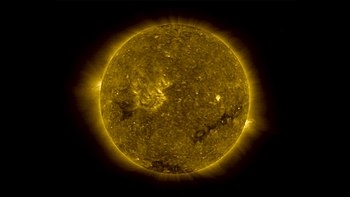Cosmic Journeys Episode 2: Attack of the Sun (HD)
Season 1
Massive solar eruptions take aim at our high-tech society. 93 million miles away... an angry sun vents its rage. Dark regions, called sunspots, appeared unexpectedly on its surface... a sign of rising tension within. It had been three and a half years since the sun last erupted in fury...at the peak of an 11-year cycl
 |
| This image is a full-disk view of the X-ray Sun and was produced by the Yohkoh solar observatory in 1991. The structures that can be seen consist of large and hot (>2MK) coronal magnetic structures. This particular image, one of millions, shows a quite active corona from near the maximum of the solar cycle. At the upper right (solar northwest) one can see an "X-ray jet") squirting outwards - this was one of Yohkoh's original discoveries. (Photo credit: Wikipedia) |
Back then, we got ready for it... by shutting down satellites that were vulnerable to high levels of radiation. But no one expected this. In what should have been a low point in solar activity, the sun erupted in a series of massive explosions, called coronal mass ejections, or CMEs.
Electrified gas clouds weighing billions of tons raced outward. Solar telescopes recorded the action... The largest emission of solar x-rays ever seen. The hottest flares, at tens of millions of degrees. And the fastest... reaching speeds clocked at six million miles per hour.
The sun became a giant plasma weapon... more potent than any in science fiction... and pointed right at our home planet. On Earth... the Halloween storms produced some of the most spectacular auroras ever seen at the north and south poles. They also brought jolts of electricity that caused power outages in Sweden, and disrupted airline navigation.
 |
| A complete 2D-Image of the Sun taken by STEREO (High Resolution) (Photo credit: Wikipedia) |
Months later, the rush of solar energy washed over the two Voyager spacecraft, on their way to the far reaches of the solar system. CMEs like these have been known to blast their way out the far edges of the solar system, where the solar wind meets the flow of gas around the galaxy itself.
This stormy season on the sun lasted about five weeks. It was by no means the worst. A solar eruption in 1859 was so powerful it set fire to telegraph offices... several people got nasty electric shocks, simply because they were working with metal objects... and for the next few nights, auroras were reportedly bright enough to read by.
A similar storm today could easily cause more than two trillion dollars in damage to our high-tech infrastructure, twenty times greater than hurricane Katrina. But believe it or not, the threat is about to get even worse. We are beginning to change the way we acquire and use energy... by expanding our power grid to accommodate wind farms...solar arrays... new nuclear plants ... and other renewable energy sources.
This grid will get larger... and smarter.... With microprocessors in most every device...communicating and negotiating with one another... running everything from air conditioners to power plants. A sudden surge of solar activity could strike the grid directly...inflicting a substantial amount of damage on the emerging smart power economy.
To understand what a powerful force the sun can be. Take a look at Venus. At almost exactly the same size and mass as Earth, it's truly our sister planet. The thinking is that long ago, fierce solar winds stripped off lighter water molecules from its upper atmosphere. What was left was a witches' brew of acidic gases and carbon dioxide that thickened at lower altitudes, rising to some 90 times the density of Earth's atmosphere.
At a concentration of 95% in Venus' atmosphere, CO2 gas trapped increasing amounts of sunlight and drove surface temperatures close to 1000 degrees Fahrenheit. How did Earth avoid such a harsh fate?
One of the main reasons is that our planet has what Venus lacks... a natural defense against solar attacks.
